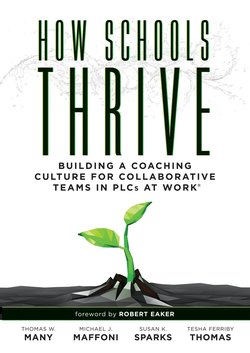Читать книгу How Schools Thrive - Susan K. Sparks - Страница 6
На сайте Литреса книга снята с продажи.
ОглавлениеTABLE OF CONTENTS
Reproducible pages are in italics.
About the Authors
Foreword
By Robert Eaker
Introduction
Taking PLC Practice to the Next Level
Using Tools to Drill Deeper
The SIG
The Pathways for Coaching Collaborative Teams
Applying the Best Thinking
Moving Forward
PART I
CHAPTER 1
Creating Habits of Professional Practice
Productivity and Collaborative Teams
The Causes of Unproductive Habits
How Habits of Professional Practice Are Formed
The Role of Clarity, Feedback, and Support
Clarity: Creating Routines Around the Right Work
Feedback: Reinforcing Routines Around the Right Work
Support: Building Capacity Around the Right Work
The Best Habits for Stacking: The Fundamentals
Moving Forward
Summary
Reflection Questions
CHAPTER 2
Identifying How PLC Elements Thrive in a Coaching Culture
The Impact of Coaching
What Is the Relationship Between Coaching and Collaboration?
What Does the Research Say About the Value of a Coaching Culture?
What Constitutes a Strong Coaching Culture, and How Do I Recognize One When I See It?
What Are Some Characteristics of a Strong Coaching Culture?
Can Coaching Change School Culture, and How Does It Impact Collaborative Culture?
Who Can Coach, and Who Is Responsible for Creating and Maintaining a Coaching Culture?
Learning Together: Collective Inquiry
Staying Restless: Continuous Improvement
Being Urgent: Action Orientation
Getting Better at Getting Better: A Results Orientation
Moving Forward
Summary
Reflection Questions
PART II
CHAPTER 3
Learning Together—The Power of Collective Inquiry
Understanding Collective Inquiry
Coaching Collective Inquiry Routines and Habits
Promoting a Spirit of Inquiry
Using the Seven Norms of Collaboration in a PLC
Example One: Secondary Language Arts Team
Example Two: Elementary Team
Coaching a Shift to a Collective Focus
Coaching to Promote Inquiry Through Questioning
Coaching to Set a Realistic Vision
Using the Inquiry SIG and Pathways Tools
Moving Forward
Summary
Reflection Questions
CHAPTER 4
Staying Restless—The Impact of Continuous Improvement
A Continuum of Professional Practice
Malpractice
Safe Practice
Best Practice
Next Practice
Reflection and Current Practice
The PDSA Cycle
Plan
Do
Study
Act
The PDSA Cycle in Action
A Long-Term Commitment
The Continuous-Improvement SIG and Pathways Tools
Moving Forward
Summary
Reflection Questions
CHAPTER 5
Being Urgent—The Value of an Action Orientation
Connecting Learning to the Work
Doing Action Research
Understanding the Action Research Process
Step 1: Identify the Problem and Create a Vision
Step 2: Learn, Research, and Explore the Literature
Step 3: Develop and Implement an Action Plan
Step 4: Observe and Collect Data
Step 5: Reflect and Share Results
Applying Findings
Using the Action-Orientation SIG and Pathways Tools
Moving Forward
Summary
Reflection Questions
CHAPTER 6
Getting Better—The Significance of a Results Orientation
Creating a Results-Oriented Culture
Measuring Progress
Broadening the Definition of Results
Using the Results-Orientation SIG and Pathways Tools
Moving Forward
Summary
Reflection Questions
PART III
CHAPTER 7
Assessing a Team’s Current Reality
Using the Four Stages of Competence
Coaching Unconsciously Incompetent Teams
Coaching Consciously Incompetent Teams
Coaching Consciously Competent Teams
Coaching Unconsciously Competent Teams
Coaching the Essential Elements as Teams Move Through the Quadrants
Moving Through the Quadrants for Collective Inquiry
Moving Through the Quadrants for Continuous Improvement
Moving Through the Quadrants for Action Orientation
Moving Through the Quadrants for Results Orientation
Moving Forward
Summary
Reflection Questions
CHAPTER 8
Believing in Your Team—Creating Collective Efficacy
Collective Efficacy
Collective Efficacy and PLCs
How to Build Collective Teacher Efficacy
Mastery Experiences
Vicarious Experiences
Social Persuasion
Affective States
Moving Forward
Summary
Reflection Questions
CHAPTER 9
Creating an Action Plan for Coaching Collaborative Teams
Stage 1: Building Shared Knowledge
Stage 2: Generating Collective Commitments
Stage 3: Providing Opportunities for Learning About the Work (Guided Practice)
Stage 4: Providing Opportunities for Doing the Work (Independent Practice)
Stage 5: Encouraging Conscious Innovation
Stage 6: Ensuring Systemic Sustainability
Moving Forward
Summary
Reflection Questions
APPENDIX A
Stages of Learning and Essential Elements of a Highly Effective PLC
Collective Inquiry
Quadrant 1: Teams Don’t Know What They Don’t Know
Quadrant 2: Teams Know What They Don’t Know
Quadrant 3: Teams Know What They Know
Quadrant 4: Teams Don’t Just Know It, They Live It!
Continuous Improvement
Quadrant 1: Teams Don’t Know What They Don’t Know
Quadrant 2: Teams Know What They Don’t Know
Quadrant 3: Teams Know What They Know
Quadrant 4: Teams Don’t Just Know It, They Live It!
Action Orientation
Quadrant 1: Teams Don’t Know What They Don’t Know
Quadrant 2: Teams Know What They Don’t Know
Quadrant 3: Teams Know What They Know
Quadrant 4: Teams Don’t Just Know It, They Live It!
Results Orientation
Quadrant 1: Teams Don’t Know What They Don’t Know
Quadrant 2: Teams Know What They Don’t Know
Quadrant 3: Teams Know What They Know
Quadrant 4: Teams Don’t Just Know It, They Live It!
APPENDIX B
Action-Planning
Action-Planning Template
Coaching Collaborative Teams in a PLC at Work: PLC 100-Day Plan Implementation Checkpoints
APPENDIX C
Communicating the Action Plan
Coaching Collaborative Teams in a PLC at Work Action Plan
Coaching Collaborative Teams in a PLC at Work Action Plan
Coaching Collaborative Teams in a PLC at Work
Coaching Collaborative Teams in a PLC at Work
Coaching Collaborative Teams in a PLC at Work Communicating the Action Plan
References and Resources
Index
